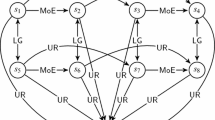Abstract
A new preference structure that includes a simple relative measure of strength of preference is developed and integrated into some of the stability definitions for the graph model for conflict resolution. In this triplet preference structure, a decision-maker may greatly prefer or prefer one state or scenario to another, or may be indifferent between them. Four stability definitions (solution concepts), Nash stability (R), general metarationality (GMR), symmetric metarationality (SMR), and sequential stability (SEQ), are extended to include strong and weak stabilities for the case of conflicts with two decision makers. Theorems that clarify the interrelationships of the strong and weak versions of these solution concepts are presented. The application of this new preference structure and the associated solution concepts is demonstrated in an environmental conflict model, called the Sustainable Development Conflict. This case shows that valuable strategic insights are gained when strength of preference is integrated into the stability analysis.
Similar content being viewed by others
References
Fang, L., K. W. Hipel, and D. M. Kilgour. (1993). Interactive Decision Making: The Graph Model for Conflict Resolution.Wiley, New York.
Fang, L., K. W. Hipel, D. M. Kilgour, and X. Peng. (2003a). “A Decision Support System for Interactive Decision Making, Part 1: Model Formulation,”IEEE Transactions on Systems, Man and Cybernetics, Part C, SMC-33(1), pp. 42–55.
Fang, L., K. W. Hipel, D. M. Kilgour, and X. Peng. (2003b). “A Decision Support System for Interactive Decision Making, Part 2: Analysis and Output Interpretation”, IEEE Transactions on Systems, Man and Cybernetics, Part C, SMC-33(1), pp. 56–66.
Fraser, N. M. and K. W. Hipel. (1984). Conflict Analysis: Models and Resolutions.New York: NorthHolland.
Hipel, K. W. (2001). “Conflict Resolution,” in M. K. Tolba (eds.), Our Fragile World: Challenges and Opportunities for Sustainable Development (Forerunner to the Encyclopedia of Life Support Systems),Vol. 1, Oxford, United Kingdom: Eolss Publishers, pp. 935–952.
Howard, N. (1971). Paradoxes of Rationality: Theory of Metagames and Political Behavior. Cambridge, MA: MIT press.
Howard, N. (1999). “Confrontation Analysis: How to Win Operations Other Than War,” DoD C4ISR Cooperation Research Program, The Pentagon, Washington, D.C.
Kilgour, D. M. (1995). “Book Review: Theory of Moves”, Group Decision and Negotiation 4, 283–284.
Nash, J. (1950). “Equilibrium points in n-person games,” Proc. Nat. Academy Sci., New York, NY 36, 48–49.
Nash, J. (1951). “Non-cooperative Games,” Ann. Math. 54, 286–298
von Neumann, J. and O. Morgenstern. (1944, 1953). Theory of Games and Economic Behavior. 1st Ed. 1994, 3rd Ed. 1953, Princeton, NJ: Princeton Universtiy Press.
Author information
Authors and Affiliations
Corresponding author
Rights and permissions
About this article
Cite this article
Hamouda, L., Kilgour, D.M. & Hipel, K.W. Strength of Preference in the Graph Model for Conflict Resolution. Group Decision and Negotiation 13, 449–462 (2004). https://doi.org/10.1023/B:GRUP.0000045751.21207.35
Issue Date:
DOI: https://doi.org/10.1023/B:GRUP.0000045751.21207.35




